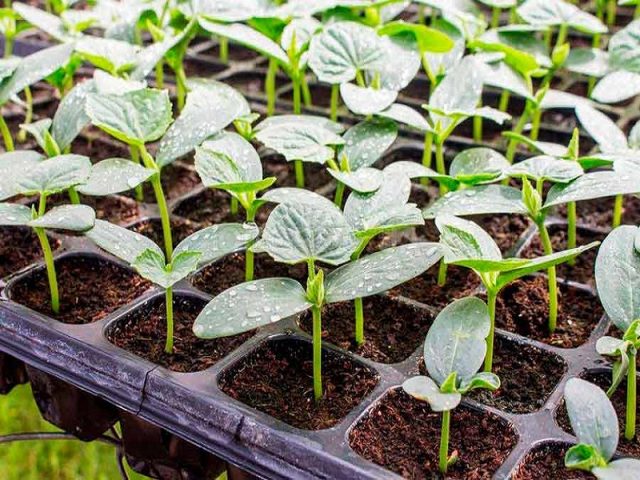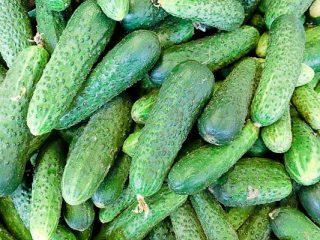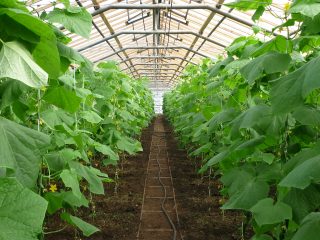Content
It is difficult to find a garden crop variety with ideal characteristics. The Arctic cucumber is very close to this definition, since it meets high requirements in agricultural technology, taste, and uniqueness of use. Reviews about the benefits of the variety indicate the possibility of growing the plant in different climatic conditions.
Description of Arctic F1 cucumbers
Cucumber Arctic F1 (another name Arena F1) is a hybrid of Korean selection, adapted to the climatic conditions of Russia. The plant is powerful, with a branched root system. It is classified as indeterminate, i.e., does not require pinching. All ovaries are located on the main stem. The Arctic F1 cucumber reaches a height of two meters, is well leafed, covered with small thorns, and has short internodes. In the axils of the leaves there are tendrils, with the help of which the plant clings to the support. The leaves are heart-shaped, five-lobed, slightly pubescent, bright green, covered with a waxy coating that protects against pests and low temperatures.Their size varies and depends on growing conditions - humidity, soil fertility, light.
The flowers are yellow, located in the axils of the leaves. In each internode of the Arctic cucumber, up to three female flowers are formed.
Description of fruits
Greens of the Arctic variety have a cylindrical shape, the length of the cucumber is 10 - 12 cm, the diameter is about 4 cm. The skin is strong, elastic, and of medium thickness. The fruit is bright green, without stripes, with small, frequently spaced tubercles and black spines. The pulp is elastic, juicy, medium density, without voids. The taste of Arctic F1 cucumber is rich, delicate, with a pronounced aroma. There is no bitterness. The seeds remain at the stage of milky maturity and are few in number. The Arctic hybrid is used fresh and for winter preparations - pickles and marinades.
Main characteristics of the variety
The Arctic cucumber variety is the result of selection by the South Korean company NongWoo Bio and belongs to the parthenocrapic hybrids. The seeds have been tested and entered into the State Register of Varieties of the Russian Federation. The variety is certified as having been acclimatized to Russian conditions.
Arctic is an early ripening hybrid, which is why the variety is used in industrial cultivation.
The plant has high immunity and resistance to pests.
Arctic is a self-pollinating variety that easily tolerates temperature changes, especially cold snaps. The fruits are set and formed without the participation of insects, which is especially important in greenhouse growing conditions. Cucumbers have high shelf life and transportability.
The drought resistance of the Arctic variety is average; the soil should always be kept moist. Excessive overheating and waterlogging can lead to the death of the cucumber root system.
Productivity
The Arctic variety is an early ripening variety. The period from the emergence of seedlings to the beginning of fruiting is 35 days. It can last up to 42 days if conditions are unfavorable. The yield of cucumber is high due to closely spaced internodes and bunch fruiting. In each internode, up to three female flowers are formed, and then high-quality greens. The plant is capable of regenerating, that is, re-forming ovaries on the lower part of the stem. Not all varieties have this property.
The first harvest of cucumbers in heated greenhouses can be obtained in early May, then regularly throughout the season.
Resistance to pests and diseases
When carrying out breeding work on the Arctic variety, much attention was paid to the plant’s resistance to disease. The hybrid has high immunity and is well resistant to the most common diseases - cladosporiosis, brown spot, ascochyta blight, tobacco mosaic, powdery mildew, fusarium. There is a high resistance of cucumber to pests - aphids, whiteflies, spider mites.
Pros and cons of the variety
Among the advantages of the Arctic variety:
- high productivity;
- the possibility of growing cucumbers indoors and outdoors;
- good transportability;
- keeping quality of fruits;
- plant resistance to air temperature fluctuations;
- immunity of cucumbers to diseases and pests;
- possibility of repeated fruiting in one season (regeneration);
- excellent taste;
- versatility of use.
The disadvantages of the variety include:
- thick skin of the fruit;
- impossibility of collecting seeds.
The skin, which is considered thick, facilitates long-term storage and transportation of cucumbers over long distances.
Growing rules
In order to get a harvest at the end of April, the seedling method of growing is recommended. For this purpose, seedlings of the Arctic variety are sowed at the end of February. Transplantation is carried out after three weeks in a heated greenhouse. The plant is tied to a trellis. Cucumber is a demanding plant and responsive to fertilizing and watering. They must be timely and periodic. Daily watering and fertilizing during fruiting bring positive results.
To grow the Arctic cucumber in open ground, both the seedling method and sowing directly into the ground are used. The timing of sowing and planting depends on climatic conditions.
Among the basic rules for growing the variety:
- the need for pre-sowing seed treatment;
- proper soil preparation;
- timely removal weed;
- watering with warm water;
- alternating fertilizing (nitrogen, organic, phosphorus-potassium);
- periodic staking of plants and harvesting.
Sowing time
In order to calculate the timing of sowing seeds and planting cucumbers of the Arctic variety in a greenhouse and in open ground, you need to be guided by a simple rule. The seedlings are ready for planting at the age of three weeks. To do this in mid-April, sowing must be done at the end of February. Plant seedlings can be planted in open ground under cover with film or non-woven material in the middle zone in mid-May. Consequently, sowing seeds for these purposes is carried out in the third ten days of April. Without shelter, cucumbers of the Arctic variety can be planted after the threat of frost has passed, that is, after June 10, which means sowing in mid-May. Depending on the climatic conditions of the region, sowing dates may shift.
Selecting a location and preparing beds
To choose the right place for planting the Arctic in open ground, you should follow the rules:
- areas protected from northern winds are suitable for cucumbers;
- in the southern regions it is worth choosing flat places to avoid burnout;
- avoid lowlands and depressions;
- give preference to sunny places;
- Close groundwater has a detrimental effect on the condition of the root system of plants.
The ideal precursors for cucumbers are legumes, which enrich the soil with nitrogen. Planting is possible after rye and wheat, acceptable after tomatoes and cabbage.
The soil for growing Arctic cucumbers must be fertile and loose, and have excellent throughput and absorption abilities. The best options for seedlings are humus, turf soil or a combined substrate of peat, humus and soil. To prepare the soil, a number of activities should be carried out:
- remove all vegetation;
- check soil acidity;
- carry out complete disinfection;
- dig up the soil;
- form beds of medium height.
How to plant correctly
Arctic cucumber seeds must be prepared for sowing - calibration, disinfection, hardening, and bubbling. You can simplify the procedure by purchasing already processed seeds.
It is better to use peat tablets, cups, and cassettes as containers for future seedlings of the Arctic cucumber variety. Peat containers make replanting painless, since the crop does not like picking. The soil mixture is prepared as follows: mix manure compost, turf soil and vermiculite in equal parts, add a glass of ash, a teaspoon of urea and a tablespoon of nitrophoska. After mixing the components, fill the container with the mixture and pour over hot water.Plant a cucumber seed into each container to a depth of 2 cm and place the pots in a warm place. After germination, the plants are transferred to a lighted place without drafts. Care consists of timely watering with warm water, additional lighting in cloudy weather, fertilizing and hardening.
Before planting seedlings in a greenhouse, it is worth preparing the soil: make beds up to 35 cm high and 80 cm wide, fertilize the soil with potassium sulfate and wood ash, superphosphate and urea. Cover the prepared ridges with film to retain moisture. You can string several rows of wire to support the cucumbers. On the day of planting, you need to make holes at a distance of 60 cm from each other in a checkerboard pattern. Their depth should correspond to the height of the pots with seedlings. The soil around the plant can be mulched with peat or sawdust up to the cotyledon leaves. About 4 plants are planted per square meter.
If the greenhouse is not heated or cucumbers are grown in open ground under temporary shelter, then the “warm bed” method can be used.
Aftercare for cucumbers
To obtain maximum yield in the first rotation, fertilizing of the Arctic cucumber is carried out leaf by leaf. Spraying should be carried out with complex micro- and macro-fertilizers together with potassium humate. The best time to foliar feed a plant is the first half of the day. During the second rotation, root feeding is carried out with potassium nitrate.
Constant conditions must be maintained in the greenhouse: temperature 22 - 28 ⁰С (daytime) and 18 - 20 ⁰С at night, humidity - 80%. Watering is carried out every other day, during the fruiting period - daily (morning and evening). The best option is drip. After watering, the soil requires loosening, and the greenhouse requires ventilation.The root system of the cucumber is close to the surface, so loosening must be done with caution. The Arctic variety is indeterminate, does not require pinching, and the fruits are formed on the main stem. The plant must be carefully and promptly tied to the trellis. Caring for it and harvesting are not labor-intensive processes.
If signs of disease are detected, treatment is carried out with special means.
Conclusion
The Arctic cucumber is a Korean hybrid grown in Russia in industrial greenhouses, but amateurs use it infrequently. The characteristics of the variety, its cultivation characteristics, and its positive qualities deserve more attention from gardeners.














